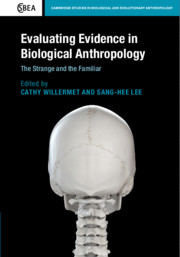Book contents
- Evaluating Evidence in Biological Anthropology
- Cambridge Studies in Biological and Evolutionary Anthropology
- Evaluating Evidence in Biological Anthropology
- Copyright page
- Contents
- Contributors
- Introduction
- Part I The Strange and the Familiar
- 1 Women in Human Evolution Redux
- 2 Hegemony and the Central Asian Paleolithic Record
- 3 Anthropology Now
- 4 The Strangeness of Not Eating Insects
- 5 Methods without Meaning
- Part II (Re)Discovery of Evidence
- Index
- References
2 - Hegemony and the Central Asian Paleolithic Record
Perspectives on Pleistocene Landscapes and Morphological Mosaicism
from Part I - The Strange and the Familiar
Published online by Cambridge University Press: 01 November 2019
- Evaluating Evidence in Biological Anthropology
- Cambridge Studies in Biological and Evolutionary Anthropology
- Evaluating Evidence in Biological Anthropology
- Copyright page
- Contents
- Contributors
- Introduction
- Part I The Strange and the Familiar
- 1 Women in Human Evolution Redux
- 2 Hegemony and the Central Asian Paleolithic Record
- 3 Anthropology Now
- 4 The Strangeness of Not Eating Insects
- 5 Methods without Meaning
- Part II (Re)Discovery of Evidence
- Index
- References
Summary
With some notable exceptions (Trinkaus and Shipman 1993; Wolpoff and Caspari 1997), paleoanthropology is the least reflexive branch of its parent discipline, anthropology. In some ways, the dramatic post-World War II corrections embedded in the New Physical Anthropology of Sherry Washburn (see Mikels-Carrasco 2012) are responsible for the loss of this theoretical lens in paleoanthropology today. The reorientation of physical anthropology represented a singular moment in history, when disciplinary self-reflection was required to salvage the scholarly field from utter vilification, given its role in the architecture of Hitler’s “Final Solution” (Proctor 1988), and to better align it with the natural sciences (Fuentes 2010; Marks 2011). With its focus on human evolution and adaptive processes, the New Physical Anthropology demanded the deconstruction of the damaging hierarchies of humans that a methodological focus on typology spurned. Washburn also sought a humanistic physical anthropology, producing scholarship that served to better society. Over the last 70 years, however, paleoanthropology has concerned itself primarily with increasing the precision of our methods and taking advantage of new technologies instead of examining the interplay between knowledge construction, power, and the validity of our interpretations. Perhaps because our focus of study is no longer alive, we have collectively forgotten about reflexivity, and this has left room for the creation of ideological hegemonies about human evolution that remain robust in the field today (Haraway 1988; Mikels-Carrasco 2012).
- Type
- Chapter
- Information
- Evaluating Evidence in Biological AnthropologyThe Strange and the Familiar, pp. 35 - 54Publisher: Cambridge University PressPrint publication year: 2019
References
- 2
- Cited by



